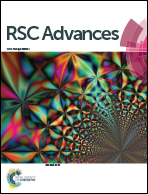Sol–gel synthesis of Ni and Ni supported catalysts for hydrogen production by methane decomposition
Abstract
NiO, NiO–CuO, NiO–TiO2 and NiO–CeO2 were synthesized by the sol–gel method and further processed into catalysts for hydrogen production by the thermocatalytic decomposition of methane. The structures of the metal oxides and catalysts were extensively characterized by transmission electron microscopy, X-ray diffraction, energy dispersive X-ray spectroscopy, X-ray photoelectron spectroscopy, temperature-programmed reduction and N2 adsorption. The catalytic performance of the catalysts was evaluated in terms of methane conversion and carbon yield. NiO had a BET surface area of 66 m2 g−1. When compared with NiO, NiO–CuO had a lower BET surface area of 13 m2 g−1, while NiO–TiO2 and NiO–CeO2 had higher BET surface areas of 161 and 133 m2 g−1, respectively. The resulting supported catalysts required increased reduction temperatures and had higher Ni 2p3/2 binding energies, indicating strong metal–support interactions. For the Ni–Cu catalyst, the introduction of copper resulted in a lower Ni 2p3/2 binding energy due to the charge transfer from Cu to the adjacent Ni atoms. The Ni catalyst showed a stable methane conversion of 0.39 at 550 °C. The presence of copper in the Ni–Cu catalyst increased the working temperature but decreased methane conversion. The Ni–TiO2 and Ni–CeO2 catalysts exhibited stable methane conversions of 0.56 and 0.60, respectively, at 575 °C. The lifetime tests of the catalysts revealed that the Ni catalyst had a life span of 600 min at 550 °C, resulting in a carbon yield of 121 g C per g Ni. The Ni–Cu, Ni–CeO2 and Ni–TiO2 catalysts had life spans of 670, 790 and 840 min at 575 °C, resulting in carbon yields of 171, 204 and 256 g C per g Ni, respectively. The structures of the resulting carbon products were characterized by transmission electron microscopy and X-ray diffraction. It was found that the morphologies of the resulting carbon products were dependent on the type of catalyst used.


 Please wait while we load your content...
Please wait while we load your content...